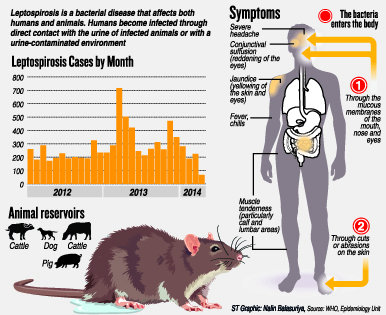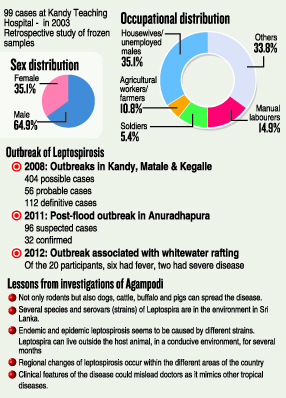News
Deadly leptospirosis not spread exclusively by rats
Will Sri Lanka have to drop the ‘rat’ in rat fever (leptospirosis) following trailblazing research by a doctor, which has gained global recognition?
Leptospirosis is being spread by dogs, cattle, buffaloes and even pigs in Sri Lanka, is the amazing finding of Consultant Community  Physician, Dr. Suneth Agampodi, who reiterates that the ‘reservoir or host animals’ are not limited to rodents. Leptospirosis is the third leading communicable disease in the country. It can be transmitted by any rodent, mammal, marsupial or bird in other countries. The misconception in Sri Lanka was that it was being spread only by rats. However, this thinking has been dispelled by Dr. Agampodi’s research. (See graphic for more findings)
Physician, Dr. Suneth Agampodi, who reiterates that the ‘reservoir or host animals’ are not limited to rodents. Leptospirosis is the third leading communicable disease in the country. It can be transmitted by any rodent, mammal, marsupial or bird in other countries. The misconception in Sri Lanka was that it was being spread only by rats. However, this thinking has been dispelled by Dr. Agampodi’s research. (See graphic for more findings)
From the frozen samples of 2003 in Kandy, the major outbreak of 2008, the cases which followed the flood in Anuradhapura in 2011 to those who caught the bug after whitewater-rafting at Kitulgala in 2012, Dr. Agampodi has been keeping an eye on leptospirosis which kills more people than dengue does in this country.
Currently he is Head of the Department of Community Medicine of the Rajarata Faculty of Medicine and Allied Sciences and it is at Anuradhapura that the Sunday Times interviewed him recently.
Not only has the research of Dr. Agampodi on this disease, referred to historically as the ‘red-eyed demon’, been published by prestigious medical journals, but it has also been successful in getting global attention focused on the largest reported outbreaks in Sri Lanka in 2008.
It was this very outbreak that he predicted, after he began analyzing notification data for this disease back in 2006 as the Medical Officer of Health (MOH) in Beruwala.

Dr. Suneth Agampodi
What caused him to do a double-take was that though as a medical student leptospirosis was just a “differential diagnosis” whenever patients with fever came into hospital, by 2006 it had grabbed third place among the leading communicable diseases in the country.
Poring over disease surveillance data then, when Dr. Agampodi predicted a leptospirosis outbreak in 2007-2008, as there had been such eruptions every three to four years earlier, and aimed his post-graduate studies for this topic, many had scoffed at him saying that he may not have “enough” cases.
“I was pretty sure that there would be a major outbreak and when I mentioned it to Dr. Ananda Amarasinghe (of the Epidemiology Unit under whose purview this disease comes), he too agreed,” says Dr. Agampodi.
Detailing his course of action thereafter, he says he began his work with a thorough literature search and found that since 2007, Sri Lanka was using Doxycycline chemoprophylaxis to prevent leptospirosis even though its efficacy was debatable.
When he challenged the use of Doxycycline as a prophylactic in leptospirosis in Sri Lanka, many were the raised eye-brows. However, a ‘brief review’ that the evidence was not strong enough for Doxycylcine as a chemoprophylaxis was published in the ‘Sri Lanka Journal of Medicine’ in 2008.
“No one believed me at that time because I was a Medical Officer,” he says, adding that the vindication of his findings came much later in 2012, when the Cochrane Collaboration which provides the best evidence for medical practice, carried out the same systematic literature review and confirmed his findings.
There was no turning back for Dr. Agampodi, who soon followed it up with retrospective investigations on the leptospirosis outbreak of 2003, carrying out an analysis of frozen serum samples stored at the Peradeniya Medical Faculty’s Department of Microbiology that Professor of Microbiology, Prof. Vasanthi Thevanesam provided him.
These investigations enabled him to determine, for the first time in 30 years, that it may not be rats which were the only culprits spreading this disease, but also dogs and cattle. These findings were published in the ‘Indian Journal of Medical Microbiology’ in 2008.
Thereafter, came Sri Lanka’s 2008 outbreak, the largest reported so far, with more than 8,000 cases in Matale, Kegalle, Kurunegala, Kandy, Gampaha, Colombo, Galle and Ratnapura. Dr. Agampodi began his exhaustive research in August 2008 at the Kandy Teaching Hospital and Matale and Kegalle Hospitals. With no grant being available, he would pump fuel for his car with money from his own pocket and be based at the Kandy Hospital while visiting Matale or Kegalle Hospitals every other day. [Later he would be partially supported by the World Health Organisation (WHO) through the Epidemiology Unit.]
Frequenting all the medical wards which had fever patients, he screened more than 700 patients, selecting “probable cases”, taking their blood and then following up each and every one of them. Laboratory confirmation of the disease had been from three tests – MAT carried out at the WHO leptospirosis laboratory in Queensland, Australia; PCR at the Mahidol Wellcome Trust Research Unit in Thailand; and qPCR/MLST typing at the George Palade Laboratories at the University of California in San Diego, USA. It had been Prof. Sharon Peacock from Mahidol who made arrangements for the testing to be done at the “best” laboratory on leptospirosis, which is the one in Queensland, he says.
With the results being published in ‘The Lancet Infectious Diseases’ in 2009, Dr. Agampodi believes that his findings drew the attention of the world to this disease in Sri Lanka. “I may be the first Sri Lankan to be the ‘first author’ in this prestigious medical publication in two or three decades,” he adds with humility.
Not content to bask in the glory of his findings, working closely with the Epidemiology Unit by 2010, Dr. Agampodi proposed the methodology to determine leptospirosis in Sri Lanka, which was published the same year in the ‘BMC Infectious Diseases Journal’. He had found to his surprise that a team of Chinese researchers were using his methodology, when he met them at an international conference.
According to Dr. Agampodi when the WHO set about studying the disease burden of leptospirosis and put out its first report, Sri Lanka was not included because the country did not have quality scientific publications on this issue. But by 2011, the scenario changed. With his findings on the 2008 outbreak being published in the ‘American Journal of Tropical Medicine and Hygiene’ where leptospirosis in Sri Lanka was described as diverse, not due to one organism, the reservoir also being diverse and risk factors being more than one, but multiple, the disease here had to be reckoned with.
“We used the Sri Lankan example to prove that the global disease burden assessment will be different,” he says.
Next he set his sights on finding out the Leptospira species in Sri Lanka, through molecular typing, which was highlighted in the ‘Clinical Infectious Diseases’ journal as the ‘major article’ as well as the ‘American Journal of Tropical Medicine’ in 2012, with his contention that “knowledge on the disease among Sri Lankans is inadequate” which got play earlier in the ‘International Journal of Preventive Medicine’ in 2011.
With his debut into the international arena with groundbreaking research, Dr. Agampodi has not gone unnoticed in Sri Lanka. He was accorded the honour of delivering the Prof. P.B. Fernando Oration at the 46th annual academic sessions of the Ceylon College of Physicians and joint meeting with the Royal College of Physicians of London in September last year.
What next for this persistent researcher?
With Dr. Chandika Gamage of the Peradeniya Medical Faculty’s Department of Microbiology carrying out independent studies on the leptospirosis infections in rats, buffaloes and cattle, Dr. Agampodi has teamed up with him for a joint human-animal study to get confirmation whether the same leptospira is causing illness in both these groups. They are being supported by a top leptospirosis researcher from the University of California, Prof. Joseph Vinetz.
Eight districts have been put under the microscope since last year in a national study being carried out as a collaborative effort among Dr. Agampodi, the Epidemiology Unit, the Department of Animal Production and Health (DAPH), with the support of Massey University in New Zealand.
After gathering information on people who are infected by leptospirosis, the veterinary surgeons of the DAPH would visit the homes of the patients and check out the animals.
Early results, unpublished yet, show that cattle, buffaloes, pigs, dogs and rodents all have the same antibodies as the patients, says Dr. Agampodi, cautioning that “we have to wait and see” whether urine cultures and tests on kidney samples will give the confirmation.
| Diagnosis – Need of the hourThe urgent need of the hour in tackling leptospirosis, according to Dr. Agampodi is:
n Rapid diagnostic kits (Elisa) for major hospitals to identify and treat the disease early, as there is under-diagnosis. n The development of diagnostic facilities including standard diagnostic facilities at the Medical Research Institute (MRI) to bring down death rates. With leptospirosis having more than 200 sub-types and 25 group classifications, a broad panel is needed, whereas MRI is using only one serovar (strain) for routine diagnosis. n Otherwise, clinicians are groping in the dark, assuming the probability of leptospirosis, which could lead to patient deaths. Clinical diagnosis of leptospirosis is also not too good, with the difficulty being that medical textbooks describe only 10-15% of the cases and the disease is not very specific in its presentation. nThe extent of the disease should be assessed to develop guidelines for clinical management. |

